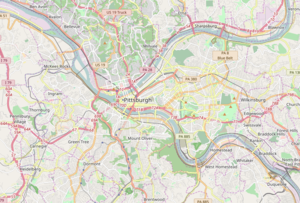Saint Anthony's Chapel (Pittsburgh, Pennsylvania)
| Saint Anthony's Chapel | |
|---|---|
 |
|
| Basic information | |
| Location | 1700 Harpster Street, Troy Hill neighborhood, Pittsburgh, Pennsylvania |
| Geographic coordinates | 40°27′54″N 79°59′01″W / 40.464889°N 79.983689°WCoordinates: 40°27′54″N 79°59′01″W / 40.464889°N 79.983689°W |
| Affiliation | Roman Catholic |
| District | Roman Catholic Diocese of Pittsburgh |
| Year consecrated | 1880 |
| Ecclesiastical or organizational status | Chapel |
| Website | saintanthonyschapel.org |
| Architectural description | |
| Architectural type | Church |
| Completed | 1892 |
| Direction of façade | Southeast |
| Official name: Shrine of St. Anthony of Padua | |
| Type | Structure |
| Designated | February 22, 1977 |
| Designated | 1968 |
Saint Anthony's Chapel is a Catholic chapel in Pittsburgh, Pennsylvania within the Diocese of Pittsburgh.
Built in 1880 by Fr. Suitbert Mollinger, who was at that time pastor of Most Holy Name of Jesus Parish in the neighborhood of Troy Hill, the chapel houses 4,000 to 5,000 religious relics, making it the largest collection of relics outside the Vatican.
As originally planned, the building of the chapel was meant to be a joint effort between the congregation of Most Holy Name and Father Mollinger, who would match their contribution. However, when the parish refused to appropriate the large sum of money needed, Father Mollinger erected the building at his own expense with money which he had inherited from his family in Belgium. After the original dedication, additions were made to house the life-sized stations of the cross as well as the growing number of pilgrims,and so the enlarged chapel was rededicated on June 13, 1892, the feast day of Saint Anthony. Father Mollinger died two days later following an operation for a ruptured stomach.
Father Mollinger was the primary driving force behind the erection of the chapel and the collection of relics housed therein. Mollinger's great personal devotion to Saint Anthony of Padua prompted him to dedicate a chapel in his name. He made several trips to Europe in order to collect relics, an unprecedented amount of which were floating in the market at the time due to political upheavals due to the so-called Kulturkampf in Germany and the unification of Italy. Most of the 4,000 to 5,000 relics in the chapel have original certificates of authenticity, the oldest of which dates from August 12, 1716.
Because Father Mollinger apparently died without leaving a will, his heirs descended on the chapel and stripped it of its crystal chandeliers, black onyx altar, candelabra, and all portable items that could be sold. The chapel and its remaining contents were subsequently sold to the parishioners of Most Holy Name for $30,000, a sum equaling about $750,000 in 2011 U.S. dollars.
...
Wikipedia

